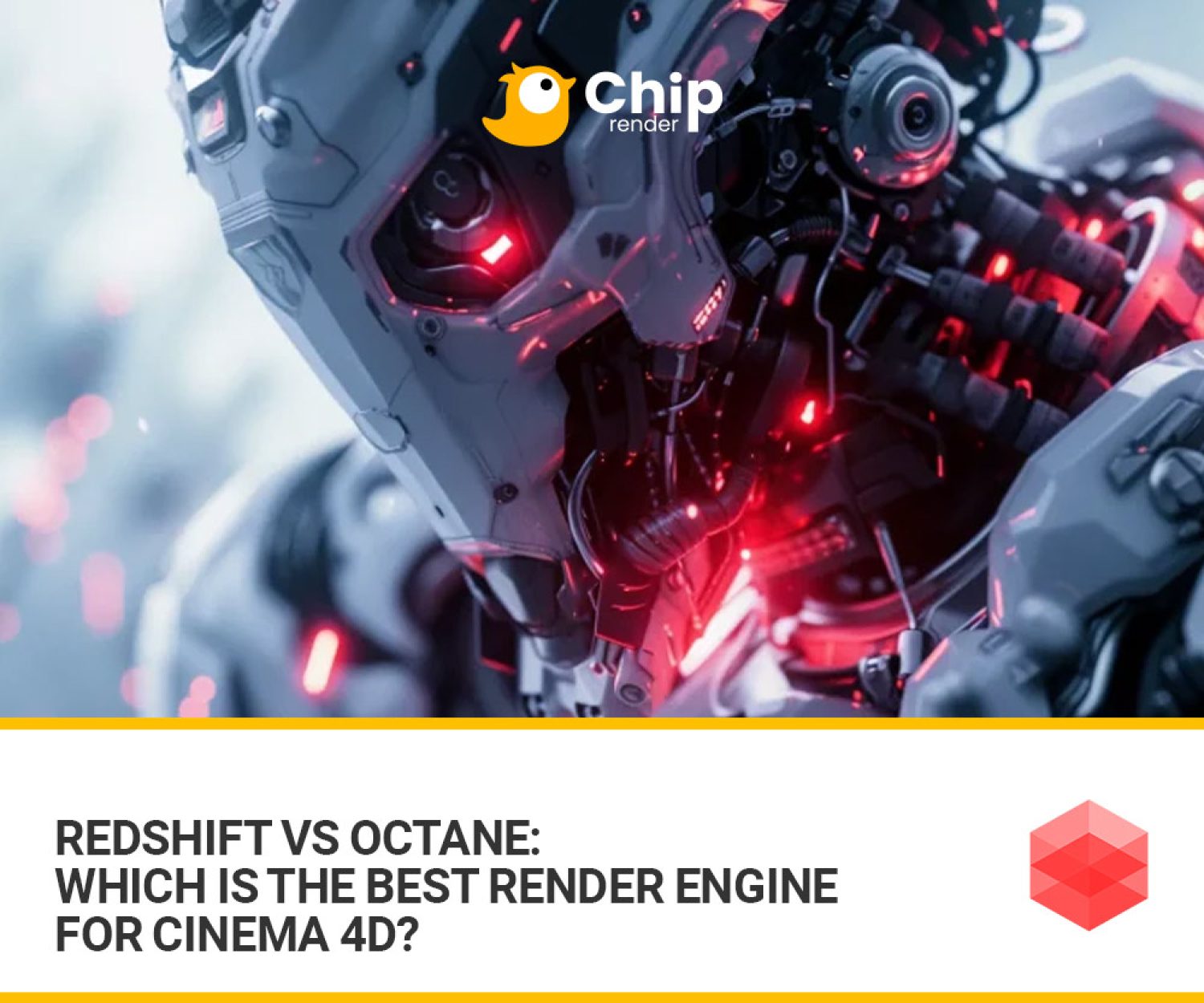Cinema 4D is a professional 3D modeling, animation, and rendering software developed by Maxon. It’s popular in creating motion graphics, visual effects, and product visualization. This software is famous for its user-friendly interface, powerful tools, and extensive capabilities. 3D artists can utilize its various features such as parametric modeling, procedural shaders, character rigging, and dynamics simulation.
Rendering is also important in 3D graphics, besides standard/ physical render engines included, have you ever wondered which is the best renderer in Cinema 4D? Let’s find out in this blog with Chip Render.
Redshift by Maxon
Redshift is the world’s first fully GPU-accelerated renderer. It’s famous for speed and quality, especially in handling large-scale scenes and high-fidelity rendering. Moreover, being a biased renderer, it allows users to freely adjust individual techniques to achieve the best performance and quality. Thus, if you’re not working under a tight deadline, you can enjoy creativity. With impressive features, Redshift is popular in visual effects for film and television.
- Compatibility: NVIDIA hardware (and some AMD versions), compatible with Windows, Linux, and limited features in MacOS.
- Price: Maxon offers 2 license packages to use Redshift with Cinema 4D:
- Maxon One: €170.97/month and access to Cinema 4D, Redshift, and other Maxon applications (Forger, Red Giant, ZBrush, etc.)
- Cinema 4D + Redshift: €127.9/ month to access Cinema 4D and Redshift utilities.

Redshift for Cinema 4D image via nemetschek.com
Advantages
- Fast: Redshift’s GPU-accelerated architecture allows fast turnaround times. Then it still ensures your render is complete on time.
- Compatibility: Operated by Maxon, Redshift is the best compatible renderer with Cinema 4D. They deliver a seamless rendering experience and support diverse features such as standard materials, lights, and cameras within the software. Also, Redshift is well-supported third-party plugins (X-Particles and Turbulence FD).
- Production-Focused Features: Redshift directly targeted 3D production environments with a wide range of rendering capabilities. For example, it supports global illumination, physically-based rendering, and advanced shading and lighting effects. Hence, users can get high-quality visual output.
Disadvantages
- Hardware Dependence: As a GPU-accelerated renderer, Redshift’s performance is closely tied to graphics hardware’ capabilities. You need to invest in high-end GPUs for optimal performance.
- Learning Curve: While Redshift’s user interface and workflow are well-designed, mastering settings and parameters may require some learning for new users.
- Effort for Realism: You can certainly achieve beautiful results with Redshift, but it will take more editing effort.
OctaneRender by Otoy
OctaneRender is another famous renderer in Cinema 4D. This GPU-based render engine focuses on delivering fast, high-quality rendering with a user-friendly workflow. With this unbiased renderer, users can have beautiful scenes with just a little adjustment. It’s favored by many artists for its speed and ability to produce stunning visuals.
- Compatibility: PC native (Nvidia GPU only), Windows, Linux, and limited features on MacOS.
- Price: OctaneRender® Studio+ Subscription costs €23.95 per month with full access to OTOY’s acclaimed OctaneRender VFX software and ecosystem.
OctaneRender for Cinema 4D image via fattututorials.com
Advantages
- Fast: OctaneRender is well-known for its fast rendering speeds, thanks to its GPU-based rendering architecture.
- Render Quality: This renderer produces high-quality, photorealistic renderings with beautiful lighting and realistic materials. It excels in simulating light behavior and creating visually stunning images.
- User-Friendly Interface: Octane features a user-friendly interface that is intuitive and easy to navigate. Its node-based material system and interactive rendering make the creation process efficient and artist-friendly.
- Community: Octane is used by many artists and studios from small to large. The biggest Octane Community is the OTOY Forums. You can find many people with the same passion as well as documents or tips for better using Octane.
Disadvantages
- Learning Curve: Mastering all the features of Octane and optimizing its settings for different scenarios can take time and practice. Users new to GPU rendering or node-based workflows may find it challenging initially.
- Hardware Dependence: Similar to other GPU render engines, Octane’s performance is reliant on GPU power. Users may need to invest in high-end graphics cards to take full advantage of its rendering capabilities.
- Quirks: The software is reported by many users to frequently crash, causing lost work and frustration. Also, difficulty navigating the renderer is noted. Users suggested that the integration of Cinema 4D into the Octane workflow needs to be improved.
Arnold by Autodesk
Arnold is a powerful third-party render engine, famous for its ability to handle complex scenes and produce exceptional results. Additionally, this is an unbiased CPU and GPU rendering engine using a technique called Monte Carlo for rendering. Arnold is popular in the VFX and animation industry as well as simulating realistic lighting and materials.
- Compatibility: CPU: Mac/PC. GPU: PC and Nvidia GPUs only.
- Price: $50 per month and $400 for a yearly subscription.

Arnold for Cinema 4D image via AURONFX ACADEMY
Advantages
- Output Quality: Arnold is proud of its ability to produce high-quality, photorealistic renders. Hence, Arnold has been the go-to for feature films with blockbusters such as The Avengers, Monster House, Pacific Rim, etc.
- Feature Rich: Many users have praised Arnold as a complete 3D package with many features, convenient for many different tasks. Reviewers appreciate the ability to add scripts and plugins, enhance functionality, and its customization options.
- Easy to Use: Several users mentioned that Arnold has an intuitive user interface that makes it easy to use, even for beginners. This user-friendly design allows for a smooth learning process and efficient workflow navigation.
- Support: Arnold has strong community support and regular updates, ensuring that users have access to the latest features and fixes.
Disadvantages
- Hardware Dependence: To take full advantage of the power of Arnold GPU, you need a new Nvidia RTX card(s). But it will need NVLink (SLI Bridge) if you want to use Arnold GPU with multi-RTX cards. Otherwise, this renderer will not scale well across cards.
- Render Speed: Arnold is known for its quality output, thus, it sometimes requires longer rendering times compared to other render engines.
- Resource Consumption: This renderer may consume a significant amount of system resources, such as CPU and memory, during rendering. This can impact overall system performance, especially when working on complex scenes with multiple light sources and materials.
V-Ray by Chaos
V-Ray is a powerful CPU and GPU rendering plugin for 3D visualization and animation. This renderer uses ray tracing technology and proprietary scene intelligence in rendering. From that, users can achieve high-quality, photorealistic renders and intricate visual effects.
- Compatibility: CPU and GPU acceleration, compatible with Windows and MacOS
- Price: from €37.9/ month

V-Ray for Cinema 4D image via chaos.com
Advantages
- Render Speed: Many users surprise with V-Ray’s fast rendering speed. You can see changes in the rendered scene quickly while still achieving realistic quality.
- Diverse Material Library: V-Ray offers an extensive library of materials and textures, as well as the ability to create custom shaders. Artists can achieve a wide range of visual effects and textures.
- Lighting and Global Illumination: V-Ray excels in simulating realistic lighting scenarios. It handles well lighting and shadow, enhances the overall visual appeal of rendered scenes.
Disadvantages
- Difficult to Learn: V-Ray’s extensive feature set may present a steep learning curve for beginners. It requires time and effort to master its advanced settings and capabilities.
- Render Settings Complexity: For some users, V-Ray’s extensive render settings and parameters may be overwhelming. Users need careful adjustment to achieve desired results.
- Resource Intensive: Achieving optimal results with V-Ray may require powerful hardware. Hence, it might increase the entry cost for individuals or smaller studios with limited resources.
Which renderer in Cinema 4D should we use?
Each project has different settings and properties, so we can’t tell you which is the best renderer in Cinema 4D. But here are some recommendations.
Redshift is suitable if you are a professional working under a deadline and need to render quickly. Furthermore, at an affordable price, it is accessible for freelancers and small to medium studios. OctaneRender is friendlier for beginners with an easy-to-use interface and a strong user community. It also guarantees you fast rendering with high quality.
If you are a filmmaker, Arnold will be a perfect choice. You can take advantage of its rich yet easy-to-use features to achieve good-quality rendering. Moreover, its cost is quite high, so Arnold is more preferred by large studios. You should use V-Ray if you want realistic rendering while still ensuring fast render times. But it also requires you to learn deeply to optimize the rendering process. With diverse license packages, you can choose one that suits your budget.
Final Thoughts
In conclusion, the four rendering engines mentioned above are all compatible with Cinema 4D and provide excellent rendering. You should carefully consider your project requirements and budget. Hopefully, our sharing will help you find your best renderer in Cinema 4D.
 Chip Render supports Cinema 4D and its render engines Redshift, OctaneRender, Arnold, V-Ray, etc. With our powerful IaaS model and 1/2/4 x GPU RTX 3090 servers, you will be able to speed up your projects several times. Join Chip Render now and have your own Cloud Workstation from only $2.9.
Chip Render supports Cinema 4D and its render engines Redshift, OctaneRender, Arnold, V-Ray, etc. With our powerful IaaS model and 1/2/4 x GPU RTX 3090 servers, you will be able to speed up your projects several times. Join Chip Render now and have your own Cloud Workstation from only $2.9.





